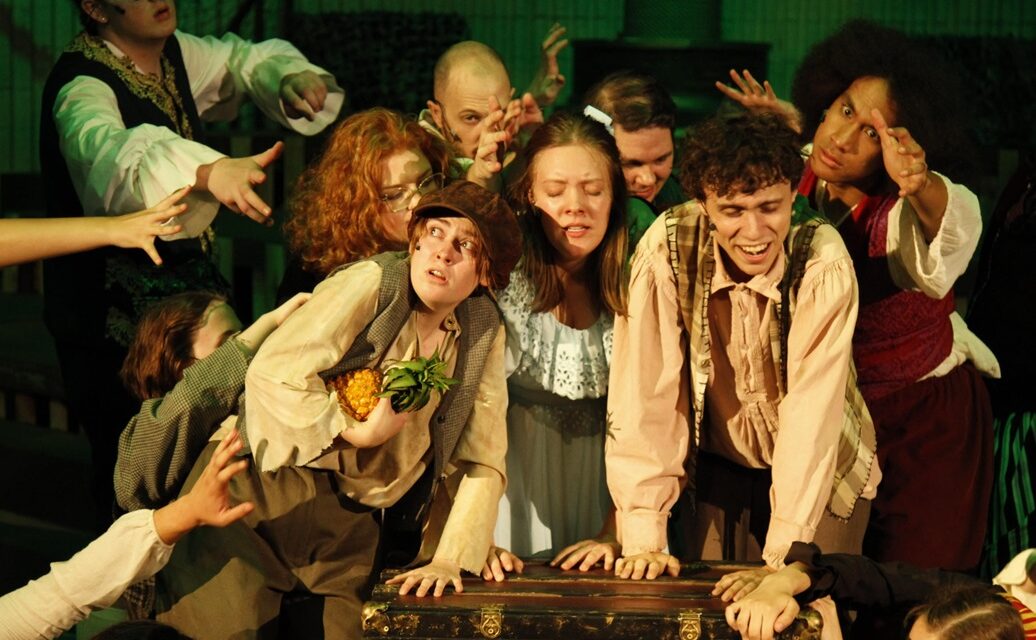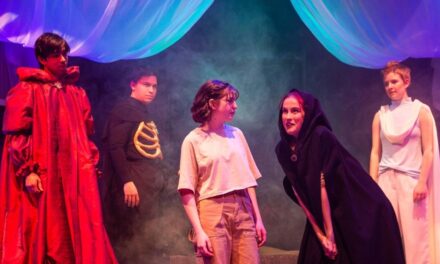MURRAY — As summer days begin winding down, there’s still exciting outdoor theatre to behold. In the recently renovated and updated Murray Arts Amphitheatre, audiences entered the space to a cadre of seafaring roustabouts singing in the aisles, “What Do You Do With a Drunken Sailor?” The actors engaged with audience members, laughed and brought an immersive and energetic feel to the show from before the production began. This served so well a show that is centered on the idea of imaginative play using one of literatures most iconic child heroes – Peter Pan.
Peter and the Starcatcher was adapted for the stage by Rick Elice and comes from a book by Dave Berry and Ridley Pearson. The story is a prequel to Peter Pan and explores how the lost boy becomes the cult hero of Neverland. Starcatcher is not written to be the kind of high-spectacle production that audiences can enjoy from the national tour of Peter Pan that is coming to Eccles Theater in November. Instead, it draws heavily on the kind of creative drama that children engage with when they find themselves outdoors with lots of time and little structure. In doing so, it allows the show to feel like a couple dozen children playing pretend.
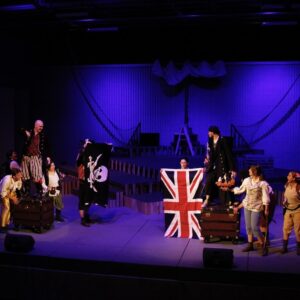
Peter and the Starcatcher Plays at Murray Park Amphitheatre through August 17.
Director Adam Wilkins absolutely nailed this. The playful preshow experience, exceptionally crisp dialogue that bounced between characters in true ensemble, humorous adlibs that I doubt will be the same two nights in a row, and simple theatricality made this show delightful. Even the choice to gender bend many roles often felt less like making the personal political and more like what would happen if the kids who came out to play that day didn’t align typically with the genders of the characters available. Play appeared to be the driving force behind all of the show’s major decisions. Community theatre should be fun, and this was a show that made me wish I was out of my seat and instead running about the stage with this jubilant cast.
Madison Howell was superb in her dual roles of costumer and choreographer. For starters, the key characters were easy to identify from their design. Molly’s pale blue wasn’t seen anywhere else on stage and helped her stand out in chaotic scenes with lots of action. Blackstache’s costume was _____ as well as being practical when he loses his hand. The lost boys and pirates were unified in look but distinct with slight differences of color, accessory and cut of their clothes. Similarly, I was astounded with big group moments that dissolved instantly from big playful staging and dancing to seamless exit transitions. Howell was a major asset to this production.
Some of the supporting roles were the most fun to watch in the entire production. Georgia Collings as Smee was a delight each time she was on stage. Smee of so many film versions of Peter Pan is bumbling, but Collings brought another layer of depth with being actively self-defeating. Smee has an idea, and instead of just dismissing it, Collings would storm away fuming, “No, stupid plan Smee. What were you thinking!” like a truly dysregulated child. The duo of Ted (Adri Ann Cumming) and Prentiss (Seth Howell) who are Pan’s closest friends brought a goofiness that allowed Pan to really despair in his downest moments. Quinton Scrhoder played the matronly Mrs. Bumbrake the way that you’d expect a teenage boy to play a 50-year old British nanny. I mean that in the best way possible. Schroder’s portrayal was less RuPaul or Mrs. Doubtfire and more “oh, look! a bonnet! I’ll be grandma.” He was funny in how clearly he was not the old lady, but committed to the bit. The ensemble was so well balanced and understood what they contributed to a great story. If word count allowed, I’d praise them all by name.
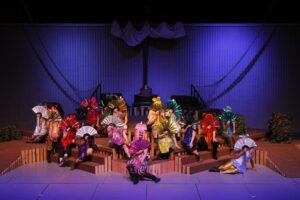
The show’s leads were solid. Trinity Medina plays the Peter Pan character who is simply called “Boy” in the program and much of the show. Medina’s true hurt was what gave life to Boy’s character. Like so many before her as a woman playing Pan, Medina played the Boy part well simply by being able to tap into the angst that comes with being a lost child. I loved the emotion Medina brought to the monologue telling Molly, “You say sorry so easily.” It could have been a temper tantrum, but it was instead well articulated cry for help.
One of the most powerful moments in the show came from Medina’s being transformed with the gift of a name. Medina and Matthew Davids, who played Blackstache, had a great balance of characters where the child is often deathly serious and the adult is whimsical but evil. It was such a lovely sequence where Medina is apprehensive until given the one thing the character wants, and then fully embraces it. Davids, likewise found plenty of moments to chew the scenery – none moreso than the scene where Blackstache loses a hand. I felt like the kiss with Molly, played by CeCe Capps, was one of the only moments in the play where the acting felt forced. Otherwise, Medina played the character with good range.
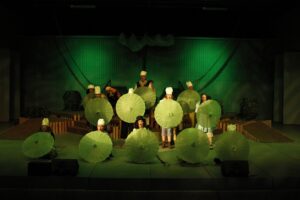
My favorite aspect of the show was the live follies effects from percussionist Angel Williams and Pianist Jennifer Hansen. There were many moments that had a little more umph because of a live sound from one or the other.
The only truly disappointing aspect of the production was the sound. Some of it was clear and well mixed. In the show’s opening moments, the ensemble stands spaced on stage and bounces line after line through the group like a pinball wizard. Much of the dialogue with four or fewer people on stage was solid. However many scenes featured a swarm of actors that overpowered the sound system and didn’t compensate for it with good articulation. Hopefully the next upgrade for the amphitheater is a sound system that can handle more volume.
The Peter Pan story has been capturing audiences for generations. The desire to never grow up and face the things that come with passing of time is a strong temptation, even if it’s never truly attainable. For one night, however, the joyful romp of Murray’s Peter and the Starcatcher on an outdoor summer stage was a delight.

These reviews are made possible by a grant from the Salt Lake County Zoo, Arts, and Parks program.

